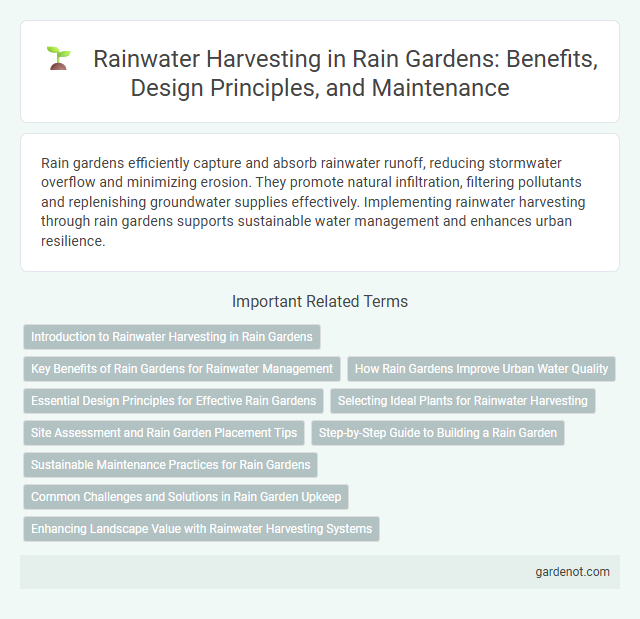Rain gardens efficiently capture and absorb rainwater runoff, reducing stormwater overflow and minimizing erosion. They promote natural infiltration, filtering pollutants and replenishing groundwater supplies effectively. Implementing rainwater harvesting through rain gardens supports sustainable water management and enhances urban resilience.
Introduction to Rainwater Harvesting in Rain Gardens
Rainwater harvesting in rain gardens captures and filters stormwater runoff, reducing surface water pollution and recharging groundwater. These gardens use native plants and engineered soil layers to enhance infiltration and remove contaminants from rainwater. Effective rainwater harvesting promotes sustainable water management by minimizing urban flooding and conserving water resources.
Key Benefits of Rain Gardens for Rainwater Management
Rain gardens play a crucial role in rainwater harvesting by efficiently capturing and infiltrating stormwater runoff, reducing surface water flooding and soil erosion. They improve water quality by filtering pollutants through vegetation and soil layers, supporting sustainable groundwater recharge. These systems also mitigate the urban heat island effect and enhance local biodiversity, contributing to resilient urban water management.
How Rain Gardens Improve Urban Water Quality
Rain gardens enhance urban water quality by capturing and filtering stormwater runoff, reducing pollutants such as oils, heavy metals, and sediments from entering local waterways. The native plants and soil media in rain gardens naturally absorb and break down contaminants, promoting groundwater recharge and decreasing surface water pollution. This sustainable water management approach mitigates urban flooding while improving ecosystem health and biodiversity in city landscapes.
Essential Design Principles for Effective Rain Gardens
Effective rain garden design incorporates permeable soil media, native plant selection, and appropriate sizing to optimize rainwater harvesting and infiltration. Strategic placement ensures runoff is efficiently captured from impervious surfaces like rooftops and driveways, reducing stormwater volume and improving water quality. Incorporating a properly graded basin with an overflow outlet prevents flooding while maximizing groundwater recharge and pollutant removal.
Selecting Ideal Plants for Rainwater Harvesting
Choosing native, drought-tolerant plants like sedges, rushes, and wildflowers enhances rainwater harvesting efficiency by promoting deep water absorption and minimizing runoff. Plants with extensive root systems improve soil permeability and encourage groundwater recharge in rain gardens. Incorporating species adapted to local rainfall patterns ensures optimal water retention and pollutant filtration, maximizing the ecological benefits of rainwater harvesting systems.
Site Assessment and Rain Garden Placement Tips
Effective rainwater harvesting begins with thorough site assessment, including analysis of soil type, slope, and drainage patterns to ensure optimal rain garden placement. Choose locations that naturally collect runoff, such as downspout areas or low-lying spots, while maintaining at least 10 feet from building foundations to prevent water damage. Proper rain garden placement enhances water infiltration, reduces erosion, and maximizes the filtration of pollutants from stormwater runoff.
Step-by-Step Guide to Building a Rain Garden
Constructing a rain garden begins with selecting an appropriate low-lying area where water naturally collects, followed by testing soil permeability to ensure adequate drainage. Excavate the chosen site to a depth of six to twelve inches, shaping it to create a shallow basin designed to hold runoff from roof gutters, driveways, or other impervious surfaces. Incorporate a mix of native plants, which enhance water absorption and filter pollutants, while layering soil amendments such as compost to improve retention and support healthy plant growth.
Sustainable Maintenance Practices for Rain Gardens
Rainwater harvesting in rain gardens enhances groundwater recharge and mitigates urban flooding by capturing runoff. Sustainable maintenance practices include regular inspection of inlet and outlet structures, removal of sediment and debris, and periodic mulching to maintain soil permeability and plant health. Implementing adaptive management techniques ensures rain gardens continue to function efficiently while supporting local biodiversity and water quality.
Common Challenges and Solutions in Rain Garden Upkeep
Rain garden upkeep often faces challenges including soil erosion, clogging of inlet and outlet structures, and weed infiltration that hinders water absorption. Regular maintenance such as removing debris, mulching to retain moisture and prevent erosion, and selecting native, drought-resistant plants effectively addresses these issues. Proper design adjustments like improving drainage and ensuring adequate soil infiltration rates enhance the rain garden's long-term rainwater harvesting efficiency.
Enhancing Landscape Value with Rainwater Harvesting Systems
Rainwater harvesting systems efficiently capture and store runoff, reducing landscape irrigation costs while promoting sustainable water management. Integrating these systems with rain gardens enhances soil moisture, supports diverse plant growth, and improves overall landscape aesthetics. By combining functionality and eco-friendly design, rainwater harvesting elevates property value and contributes to urban green infrastructure.
Rainwater harvesting Infographic

 gardenot.com
gardenot.com